The Middle Rodentocene: 10 Million Years Post-establishment
The Middle Rodentocene: 10 million years post-establishment

Better Ungulate than Never: The Hamtelopes
A small, but abundant and diverse herbivore common across the land during the Middle Rodentocene are the hamtelopes (family Cervimuridae), which are found on most of the continents by this point in the planet's history. Looking a fair bit like small ungulates, hamtelopes are browsers, feeding on higher vegetation such as bushes and shrubs, and thus avoid competition with grazing cavybaras when the two coexist on the same turf.
Among the many species of hamtelopes, the most remarkable is the Rusty Hamtelope (Erythrocervimys bambini), which is unmistakable due to its distinctive reddish-orange hue of its coat. On Earth, such a color for a forest-floor browser would be highly disavadvantageous, sticking the animal out into plain sight and leaving it vulnerable and visible to predators.
However, HP-02017 is distinguished by the presence of a second minor sun, Beta, that orbits further out from the main sun Alpha and for a large portion of the year is opposite the main star, making Beta appear by night and illuminate the landscape in a phenomenon called "Beta-twilight". Beta-twilight is when the rusty hamtelope is at its most active, as well as dawn and dusk: and in the fiery glows of sunrise and sunset, or the red-orange Beta-twilight landscape, the rusty hamtelope demonstrates that Earthly life can adapt even in conditions not normally found in Earth, camouflaging perfectly in the forest floor while the forest is bathed in a faint, scarlet hue.

But as remarkable as the rusty hamtelope is, the clade of hamtelopes is not merely limited to this one genus. Hamtelopes have reached peak diversity in the Middle Rodentocene, spanning several genera and dozens of species. Some, such as the long-legged ratzelles (Cervicricetus spp.) are daytime grazers of the forest floor, and indeed even share habitat with the rusty hamtelope by different times of activity to minimize competition. Others, such as the ramsters (Capramys spp.) are more at home in the alpine tundras and high plateaus, leaving a lifestyle akin to that of mountain goats, agile and surefooted as they climb up steep cliffs to graze on mountainside vegetation.
But by far the most unusual members are the toponies (Microhippoides spp.) which are plains-dwellers resembling tiny, tailless equids. What makes them particularly odd is how small they are, compared to the other genera: this in fact is due to competition with larger, bipedal hopping jerryboas that have usurped their niche out in the open plains. Able to travel longer distances with their more energy-efficient bounding gait and defend themselves from predation with sharp hind-limb claws, the jerryboas very quickly dominated the open grassland and savannah, leaving only the niche of small grazer vacant for the toponies.
As new lineages emerge and diversify in the Middle Rodentocene, their more divergent forms begin to clash with one another in ecological terms. In the end, some families will dominate, others will barely hang on and others will completely die out, as hamster diversity climaxes in the Rodentocene's halfway mark.
▪▪▪▪▪▪▪▪▪▪
More Posts from Enbylvania65000 and Others
Just realised tumblr allows html editing, but the other reasons still apply. Also, it's just not the same editing within the confines of a tumblr panel and doing so from a website you can fine tune the layout of and control the comments on etc
I feel like maybe starting a blog again I want to write in depth posts about topics with full html support And I also want to talk politics in a public space without all the problems of talking politics on social media. Especially I want to keep my tumblr account mostly non-political.
Also first time posting in months Again. Or even checking tumblr. But this is my only social network now (stopped using twitter even before the fiascos with Musk) and I kind of miss having that. But I also find myself with a lack of anything to share. Life has been pretty boring in most non-political regards.
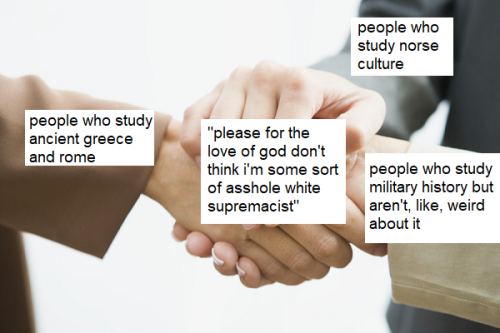
felt inspired to make this after reading some of the comments on my post about liking history
The Middle Rodentocene: 10 million years post-establishment

Retro Rodents: The Furbils and Duskmice
By 10 million years PE the hamsters have diverged into many different forms, such as ungulate-like runners, mustelid-like predators or macropod-like hoppers. But while some of the resident rodents have further specialized away from the basic rodent body plan, two lineages, the furbils (family Caudatocricetidae) and the duskmice (family Cricetomuridae) are notable in having retained fairly conservative rodent anatomy, and are all the more successful for it: these two unassuming lineages have attained a diversity rivalling that of the jerryboas, and fill nondescript mouse, rat, hamster or gerbil niches all across the world.
The furbils, the more derived of the two lineages, are highly social creatures with long, tufted tails, displaying a very marked sexual dimorphism in many species, with dull, drab females and extravagantly-adorned males sporting striking markings and decorative tufts and manes of fur, which are used for display and attracting mates. Furbils tend to live in harems of several breeding females and one dominant male, while younger males are typically solitary and roam about searching for an opportunity to breed with any receptive females. Furbils are omnivores, feeding on insects, invertebrates, seeds, nuts and fruit, and males are known to attain their brilliant colors from pigments in their food: their colorful fur serving as an honest advertisement to their good health.
Male furbils are highly territorial, with the most brightly-colored and brilliantly-patterned males being the ones most attractive to females. This same coloration makes them more conspicuous to predators, as an unfortunate side effect: however, the fact that it gets them a higher chance to breed nonetheless allows them to more effectively spread their genes at the cost of individual longevity-- and in addition, essentially shows off their fitness by advertising an intentional handicap: a male that survives to breeding age even with such visible colors must be a very fit individual indeed, as far as females are concerned.

The most distinctive furbil characteristic of all is their long tail, which depending on the species serves a wide array of functions: for display, social signaling, or balance. One lineage of furbils, however, the subfamily Caudotomae, have a different, more drastic use of their tails: as a defensive measure used to divert predator attacks.
The Caudatomae are unusual among their furbil kin as they are solitary and come together only to mate, and as such lack the marked sexual dimorphism of their cousins. They have instead opted their tail into a lure, with the tuft at the end serving to draw predator attacks away from their body and head. Usually this is only meant to distract the predator and allow the furbil to escape: however, should the tail be caught, the furbil can actually detach it completely and flee from danger, as a special joint at the tail's base allows it to break off with little injury when sufficient force is applied. Unlike lizards who use a similar tactic, however, the tail-dropping is a one-time trick in the animal's whole lifetime, as it does not regrow once shed-- as such, it is a costly sacrifice that is only used as a last resort if no other means of escape is possible.
One very peculiar species, however, has compensated with the lack of mammalian regeneration with a downright absurd adaptation: multiple fracture points along the length of its tail. Known as the fuse-tailed dynamouse (Fragmacaudamys cabuum), it can fracture off its tail a maximum of up to three times, as its tail is comprised almost entirely of three very long and stiff vertebrae. Its reddish fur camouflages it well in Beta-twilight, the time when it is most active, but a conspicuous yellow tuft on the end of its tail serves as a predator distraction tool. If the tail breaks off at a joint the tail quickly heals the end of the stump and a new tuft of yellow hair soon grows around the injury, restoring the form and function to a now-shorter tail. Once a dynamouse has broken its tail three times, the tuft forms directly at the base of its rump, and while no longer to shed any more segments, can still serve as a distraction by making predators attack the wrong end and still giving the now-truncated dynamouse a fair chance to flee.

Just as strange and diverse as the furbils are the even more basal duskmice, small, stocky short-tailed rodents that still very closely resemble their hamster ancestors. Duskmice are a diverse group numbering nearly a hundred species, most of which are nondescript mouse-like seed eaters that hoard food in burrows and emerge at night and sometimes at Beta-twilight to forage, avoiding the many diurnal predators active during the day.
Some duskmice, however, have taken off to unusual niches, to take advantage of food sources beyond the reach of other hamsters. One genus, the molemice (Subterramys spp.) have adapted into specialized burrowers, developing large clawed forepaws for shoveling away dirt and hairless flat noses to push loose soil aside. They tunnel underground in search for roots, tubers and worms, and rarely ever come to the surface unless disturbed or if their burrows are flooded by heavy rains.
Another duskmouse lineage, the pondrats (Aquacricetus spp.), have instead taken to the water to feed on aquatic invertebrates and water plants that occur in abundance in freshwater bodies such as lakes and streams. They are the first hamsters on HP-02017 to specialize to a water-dwelling lifestyle, and as such have utilized a very unusual part of their anatomy to thrive in wet habitats: their cheek pouches. Acting as both flotation device and air storage, they can contract specialized muscles in their cheeks to compress the air, allowing them to sink and dive, and when returning to the surface quickly reinflate their cheek pouches to rise quickly to the top. Due to this specialization the cheeks can no longer be used as a food storage, and the pondrats instead hold food in a new different set of pouches that open lower in their mouths, surfacing every now and then to feed on their haul while floating at the surface.
▪▪▪▪▪▪▪▪
And thus with the duskmice ends the list of diversity in the Middle Rodentocene, the peak of speciation in a world of the small and scurrying. Our next stop will be at the Late Rodentocene, 20 million years PE: a time of even more diversity, but one that heralds the end of an age-- and a new promise of even greater things to come.
▪▪▪▪▪▪▪
All art is derivative. Yes, there should be protections of the rights of artists that their work can't be used in databases of AI art without consent. And yes AI does not consciously create art. In that sense, it is a tool for creating art. I don't see why these things make AI art inherently wrong or anyone using them wrong. By the way, I have only ever shared AI art with a small number of friends and only from programs I trust to be using public domain datasets You shouldn't paint everyone using AI for art with the same brush.
AI Art and Why It Can Go Die In A Fire
Why am I opposed to Stable Diffusion and AI Art in its current incarnation:
Some people seem to believe AI can “learn” art. Like it learns the concepts of perspective, value, anatomy, colour etc. through images and then recreates art based on this knowledge.
This is a misconception.
An AI doesn’t “know” things. It has no concept for artistic fundamentals. It just learns associations based on the data it’s given in a way that’s completely , vastly different to the way a human brain does. An AI can only recreate based on known image data. Those recreations can be blended in a very complex way, but they will ALWAYS be derived directly from image data it’s trained on.
A human can take a paint-bucket, and throw it at a canvas, and then mush paint around with their fingers. An AI can’t do that; it can only blend image data that best fits “canvas with messy splashed paint”. It will pull from all the image data it’s categorized with “canvas”, “splash”, “paint”, etc. and then blend them by placing datapoints next to other datapoints that it has “learned” will most suitably go next to each other.
Human learning creates complex conceptual structures. Our concept of an “apple” may contain many elements such as the colour red, how heavy it is, its overall form, how you hold it, and what it tastes like. An AI’s concept of an “apple” is whatever images it associates with the word “apple” based on text cues in its training.
When you tell it to paint “a hand holding an apple”, it will recreate and blend many images of hands with many images of apples in a way that best fit each other depending on weights defined by the data its analyzed.
Any presumption that AI can “learn” art theory and then make art through its knowledge of this is incorrect, and would require a level of general AI intelligence we are nowhere near capable of building yet, and we won’t with our current models because they are not creating actual epistemology, merely datapoint-based imitation without actual integration or understanding.
But the bottom line? All AI art is derivative and, unless it was trained exclusively on works in the public domain, there is definitely a case to argue that the companies creating these algorithms are violating the copyright of the artists whose works they are using without there first being a contract, agreement, or royalties (which is the thing these companies are trying to weasel out of by creating these AIs in the first place.) There is a reason why Clip Studio Paint, the latest of money-chasers jumping aboard the Stable Diffusion pony, issued out a warning that states, verbatim, “we cannot guarantee that images generated by the current model will not infringe on the rights of others.“
They know. They just don’t care- and everyone who ‘creates’ AI art is a willing participant in the infringing of copyright of millions of artists who never gave consent to have their works used in this fashion.
I have a Twitter account devoted to Aeniith only now! Go follow me on @Aeniith_ if you’re so inclined!
Tidbits, musings, ideas, fact, and more on worldbuilding, conlangs, etc.

Why Gritty Why

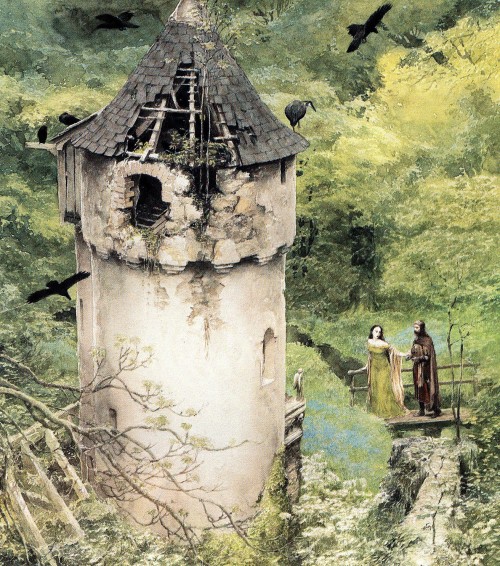
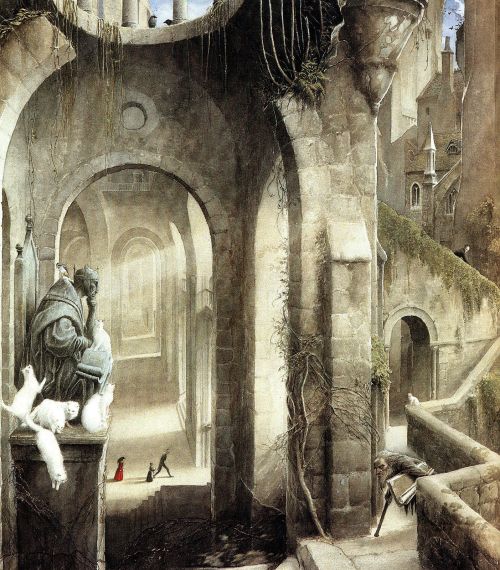


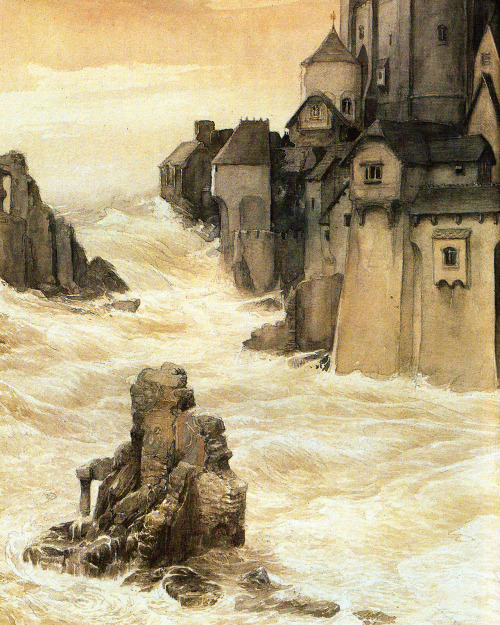
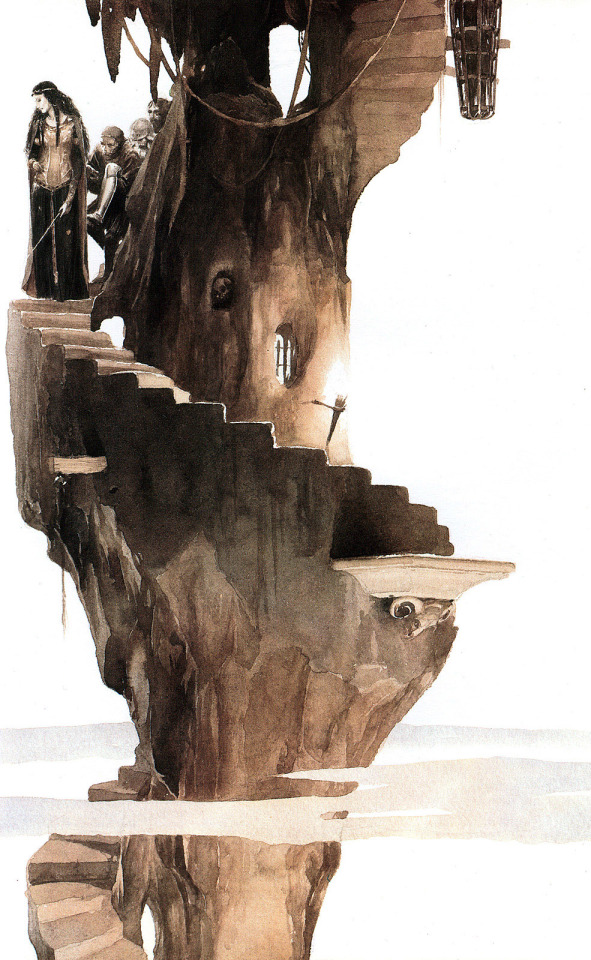
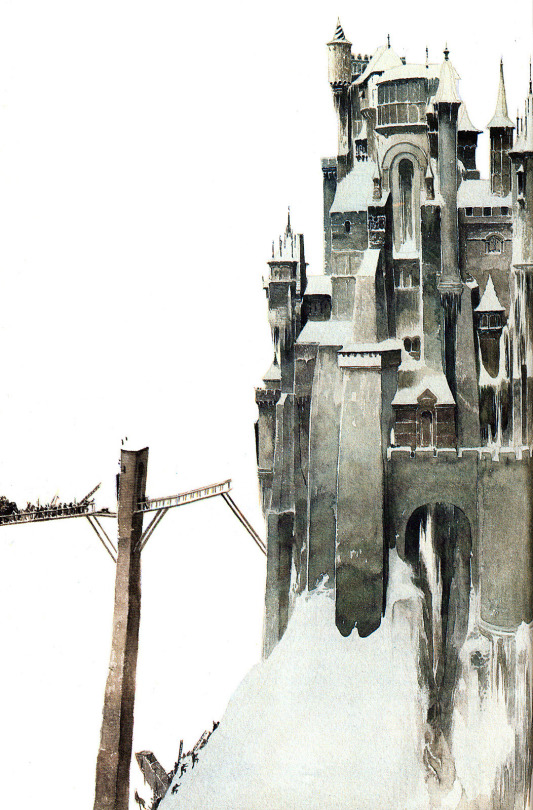
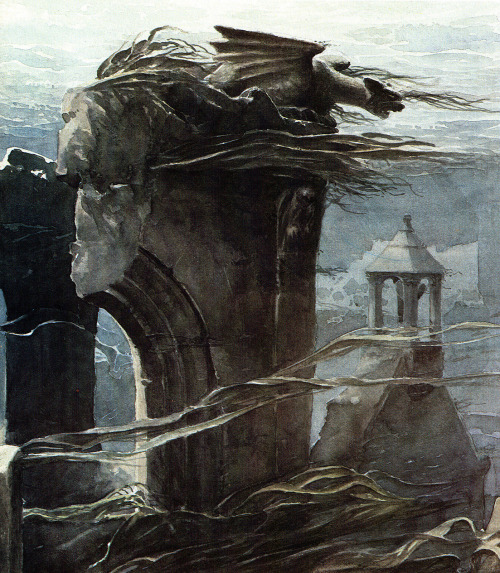
Castles - art by Alan Lee (1984)
Same but I'm terrible at thinking of ways to do this
God i missed you dude but umm, what would you say is your favorite way to add new words to your lexicon? Are you a suffix guy, prefix, infix if you're feeling spicy? Or something else?
For me, the most satisfying coinage is a natural metaphorical extension that I hadn't thought of previously. For example, keligon is "stop" in High Valyrian, and kelinītsos is a pause or a break, but I extended the latter metaphorically to mean "chance" or "opportunity"—a moment when things stop briefly, and you have a chance to do something. Rather than it being your chance, it is your pause: What will you do while things have stopped very briefly, affording you a window of opportunity?
-
 nolimitjayski24 liked this · 1 month ago
nolimitjayski24 liked this · 1 month ago -
 arcasvethix liked this · 4 months ago
arcasvethix liked this · 4 months ago -
 keresacheron liked this · 8 months ago
keresacheron liked this · 8 months ago -
 el-recaptas liked this · 9 months ago
el-recaptas liked this · 9 months ago -
 theenderreddit liked this · 9 months ago
theenderreddit liked this · 9 months ago -
 imperialinquisition liked this · 11 months ago
imperialinquisition liked this · 11 months ago -
 thereadingmonarch liked this · 1 year ago
thereadingmonarch liked this · 1 year ago -
 mayfay liked this · 1 year ago
mayfay liked this · 1 year ago -
 monster-creator-12 liked this · 1 year ago
monster-creator-12 liked this · 1 year ago -
 xaeyrnofnbe reblogged this · 1 year ago
xaeyrnofnbe reblogged this · 1 year ago -
 cricketbombed liked this · 1 year ago
cricketbombed liked this · 1 year ago -
 eldritch-orange liked this · 2 years ago
eldritch-orange liked this · 2 years ago -
 rodent178 liked this · 2 years ago
rodent178 liked this · 2 years ago -
 darkwingphoenix liked this · 2 years ago
darkwingphoenix liked this · 2 years ago -
 lone3321 liked this · 2 years ago
lone3321 liked this · 2 years ago -
 herobrinna reblogged this · 2 years ago
herobrinna reblogged this · 2 years ago -
 herobrinna liked this · 2 years ago
herobrinna liked this · 2 years ago -
 trashysaur1125 liked this · 2 years ago
trashysaur1125 liked this · 2 years ago -
 am-the-morning-hour reblogged this · 2 years ago
am-the-morning-hour reblogged this · 2 years ago -
 i-do-unimportant-things liked this · 2 years ago
i-do-unimportant-things liked this · 2 years ago -
 manoszilla399 liked this · 2 years ago
manoszilla399 liked this · 2 years ago -
 aem9phase liked this · 2 years ago
aem9phase liked this · 2 years ago -
 smb62 liked this · 3 years ago
smb62 liked this · 3 years ago -
 potatosapien5 liked this · 3 years ago
potatosapien5 liked this · 3 years ago -
 tundragravedigger liked this · 3 years ago
tundragravedigger liked this · 3 years ago -
 littlemooncity liked this · 3 years ago
littlemooncity liked this · 3 years ago -
 itswhomp liked this · 3 years ago
itswhomp liked this · 3 years ago -
 capnportofficial liked this · 3 years ago
capnportofficial liked this · 3 years ago -
 kenzietensei liked this · 3 years ago
kenzietensei liked this · 3 years ago -
 kobold-king liked this · 3 years ago
kobold-king liked this · 3 years ago -
 bestia-02 liked this · 3 years ago
bestia-02 liked this · 3 years ago -
 ajaajka liked this · 3 years ago
ajaajka liked this · 3 years ago -
 cdbeetle43 liked this · 4 years ago
cdbeetle43 liked this · 4 years ago -
 thoughts-are-complicated liked this · 4 years ago
thoughts-are-complicated liked this · 4 years ago -
 cannotfindagoodusername liked this · 4 years ago
cannotfindagoodusername liked this · 4 years ago -
 enbylvania65000 reblogged this · 4 years ago
enbylvania65000 reblogged this · 4 years ago -
 enbylvania65000 liked this · 4 years ago
enbylvania65000 liked this · 4 years ago -
 thebamboozlerblr-blog reblogged this · 4 years ago
thebamboozlerblr-blog reblogged this · 4 years ago -
 itg15 liked this · 4 years ago
itg15 liked this · 4 years ago -
 a-peculiar-potoo reblogged this · 4 years ago
a-peculiar-potoo reblogged this · 4 years ago -
 a-peculiar-potoo liked this · 4 years ago
a-peculiar-potoo liked this · 4 years ago -
 thebamboozlerblr-blog liked this · 4 years ago
thebamboozlerblr-blog liked this · 4 years ago -
 unidentifiablelifeform liked this · 4 years ago
unidentifiablelifeform liked this · 4 years ago -
 ouppygirlcity liked this · 4 years ago
ouppygirlcity liked this · 4 years ago -
 creaturedeityendless liked this · 4 years ago
creaturedeityendless liked this · 4 years ago -
 ghst-theghst liked this · 4 years ago
ghst-theghst liked this · 4 years ago -
 starry-system reblogged this · 4 years ago
starry-system reblogged this · 4 years ago

